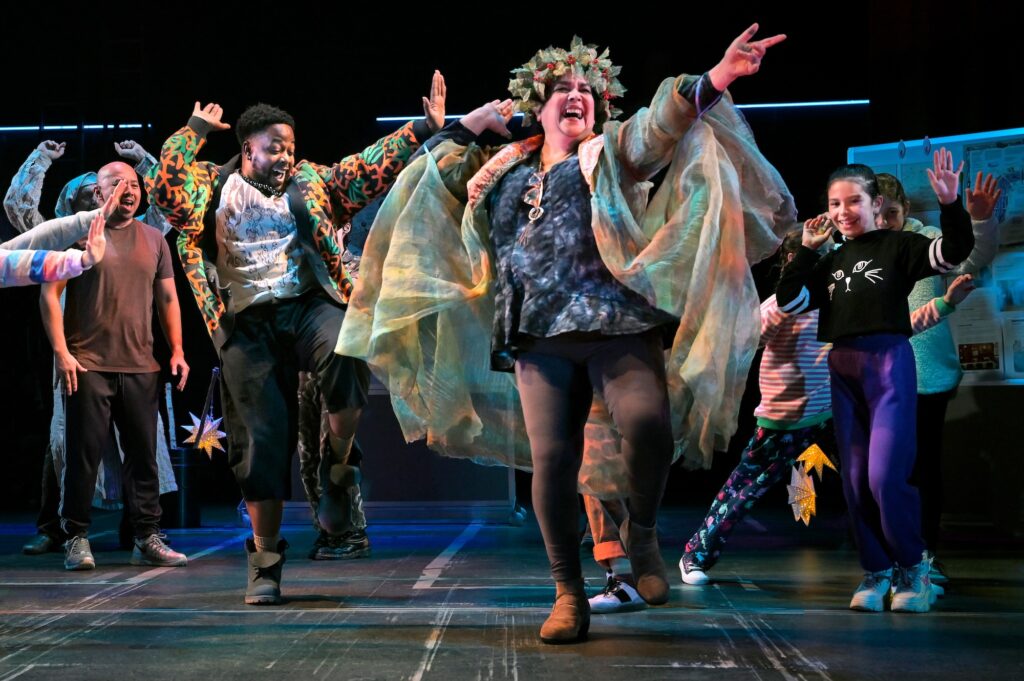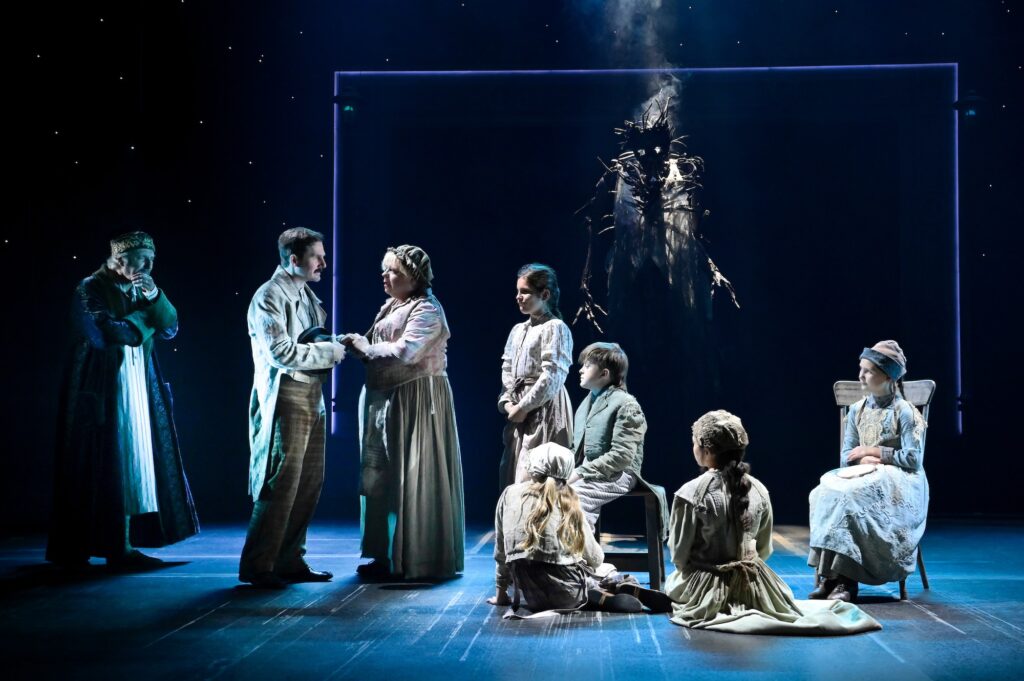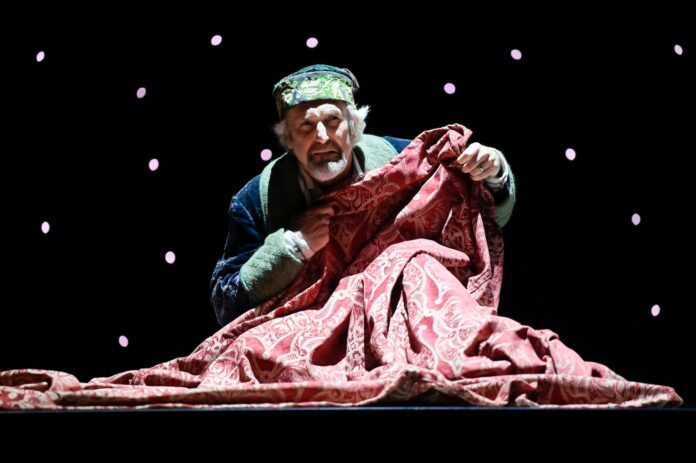This is Drama Masks, a Bay Area performing arts column (full of mad ramblings, Oxford commas, and “theatre” with an “r-e”) from a born San Franciscan and longtime theatre artist in an N95 mask. I talk venue safety and dramatic substance, or the lack thereof.
If it’s unseasonably warm (climate change), self-esteem is traditionally low (seasonal depression), and everyone you know needs a GoFundMe donation (I know from where I speak), then it must be mid-December. It’s the time of year where people are asked to make the second-greatest sacrifice for the good ‘ol US-of-A: If the first is to die for Old Glory, the second is to go broke filling the pockets of retail oligarchs. Patriotism!
And what better way to mark the economic hypocrisy of the season than with multiple productions of that story from Victorian-era SJW Charles Dickens. You know the one: where the heartless Capitalist has to go through the horror story that is his own life before he sees the benefits of altruism. It’s the public domain tale about the evils of the rich are horrible people for which countless adaptations, parodies, and homages have made billions for corporate entities. The show is such an annual inevitability that the only thing that comes close to its ubiquity is a show that’s “80% narrative filler”.
Despite the perception of the Bay Area as overall countercultural and shunning of tradition, Bay Area theatre offers multiple productions of Dickens’ morality tale every year–though most often miss the overall lesson. I myself had to skip the opening of Center Rep’s version because I needed a mental health day. I recently caught the opening of a different version and happened to sit near a cast member from Theatre of Yugen’s Noh version (back after a five-year absence).
The two versions I did see created a curious dichotomy: both world premieres with radically different goals in terms of the messaging, but they have so much in common, production-wise. Both are meta-theatrical versions of the story that aim to deconstruct popular preconceptions of the story; both use a set design meant to imply a lack thereof, with the walls of the stage and numerous costume hangers visible through the run of the show; both make DEI a narrative point in their post-modern plot lines. Yet, the opposing intentions of both shows is apparent by looking at who produced each version.

One is by ACT, debatably the flagship theatre company of both San Francisco and Northern California, with corporate sponsors galore to fund its annual production of A Christmas Carol, which has been continuously produced, in one form or another, since 1976. The other is by SF Mime Troupe, the loud ‘n leftist collective that accepts only personal donations to put on travelling shows held together with string, tape, and pure moxie. Although both premieres were workshopped and planned a couple years in advance, each show represents how its creators intend to represent themselves in the looming political turnover.
For ACT, the idea appears to be to reassure centrists and moderates that “It’s OK, you did nothing wrong by refuting a hardline stance on, well, anything.” When the company retired former AD Carey Perloff’s version after 20 years last December, successor Pam MacKinnon personally commissioned former collaborator Craig Lucas (Prelude to a Kiss) to author a new one. The result is A Whynot Christmas Carol (through December 24 at the Toni Rembe Theater, SF), a would-be tribute to the craft of theatre and the continued relevance of Dickens’ story.
Sadly, in trying to combine the two, it does both a disservice. Lucas’ script fancies itself a Noises Off!-style story about the low-budget Whynot Theatre somewhere in the heartland staging the show, but Lucas’ text seems uninterested in the goings-on. The show opens with a ghost light and the young actor (Piera Tamer) drawn to it like a moth to a flame. We hear voices of those seeming to be the play’s characters before our ensemble enter to put on their poorly-produced new version of the show.

But none of it lands. Lucas and MacKinnon (who also directs) are blessed with a murderer’s row of top-notch Bay Area talent—from Stacy Ross as the show-within-a-show’s director and Gianna DiGregorio Rivera as a skilled PA to Catherine Castellanos as a speech-impeded actor and Sara Toby Moore as a willing do-all company member. But the characters never become people. The things they do backstage during rehearsal are meant to bleed into the play itself, but it never happens organically.
For instance, two folks are caught on a hot mic disrespecting a cast member (in a scene straight from Living in Oblivion) and are expected to apologize later, because that’s the trope; there’s never any indication they’re truly sorry or that they’ve learned from the experience. Similarly, DEI initiatives are railed against by one cast member who seems no different by show’s end, but is expected to now be welcomed with open arms. These aren’t people, they’re plot points, with confused politics behind them.
What’s more, there’s actually a cool production of A Christmas Carol fighting to burst out. David Zinn’s elaborate sets and Amanda Villalobos’ puppets betray any pretense of Whynot Theatre being “low-budget,” but it works for the show-within-a-show. The striking designs of all the tech crew make for an immersive show and are worth admission alone. (As is the decent Rembe HVAC, which kept CO² levels on my Aranet4 from going any higher than 1,558ppm by the final bow.)
But it all just highlights how MacKinnon and Lucas would have been better served doing a straight adaptation, rather than a clumsy meta version that forgets it’s a meta version. It’s clear that they (like Ross’s director character) wanted to distinguish themselves from previous versions, but all they’ve done is highlight why those versions were so beloved. And the fact that it only brings up political talking points as flimsy traits for one-dimensional characters shows either an ignorance or indifference to those points, neither of which the world needs right now.
A WHYNOT CHRISTMAS CAROL’s world premiere runs through December 24 at the Toni Rembe Theater, SF. Tickets and further info here.

Whereas Lucas’ script seems to refuse to take a political stance, Michael Gene Sullivan’s A Red Carol (world premiere through December 29 at Z Space, SF) wears its opinions on its sleeve like the big red star on the company logo. After all, it wouldn’t be an SF Mime Troupe show if its politics weren’t shouted loud for the folks in the back row.
After several years in development, Sullivan directs his own adaptation with the intention of bringing the show back to its anti-Capitalist roots. That means using a set meant to resemble a camp of unhoused people and direct-to-audience addresses about how many prepubescent deaths Dickens’ highlights during his story.
The show features Bob Crachit (Brian Rivera) as both the most prominent meta-narrator of the ensemble, and the only person besides Scrooge (Mike McShane) to play only one character (though Crachit does later takes on a notable second façade). It reminds—nay, announces loudly—to the audience that Scrooge shouldn’t be considered the central character anymore than Peter Pan should when the central character is in fact Wendy. Crachit and all the non-Scrooge characters personify poverty, but are also clearly Dickens’ heroes, which is why this show apotheosizes them.

In typical Mime Troupe fashion, it can be a bit much. Their hammer-to-the-head messaging eschews subtlety, and history lessons (poor taxes, workhouses, “the treadmill”) are intentionally preachy. But this an adaptation that, through serendipitous timing, shows why the public would celebrate the killer of a greedy insurance CEO. That incident isn’t incorporated into the show, but it shows just the sort of radicalized mind that would relate to a frequent medical patient instead of his affluent victim.
Given how democracy was just bought and paid for by oligarchs, it’s a reminder everyone could use now. (The large hall of the Z Space main theatre meant CO² levels on my Aranet4 were only 890ppm by the end of the 100-minute show.)
A RED CAROL’s world premiere runs through December 29 at Z Space, SF. Tickets and further info here.
Incidentally, another commonality of both shows was that neither produces a very menacing Scrooge. Part of the arc is that he’s supposed to be terrifying to folks like Crachit and the singing child before he himself has his greed literally scared out of him. The Scrooges in both these shows were miserly, but not scary.
But maybe that’s just a personal hang-up of mine? After all, we live in a world where the Ebenezer Scrooges, Gordon Gekkos, and Mr. Potters of the world are considered the heroes. One has to wonder what ghosts are scary enough to make them see the light? One of these two shows had the money to design a truly terrifying ghost, but the other reminds us why the Scrooges of the world should be afraid. Always.





